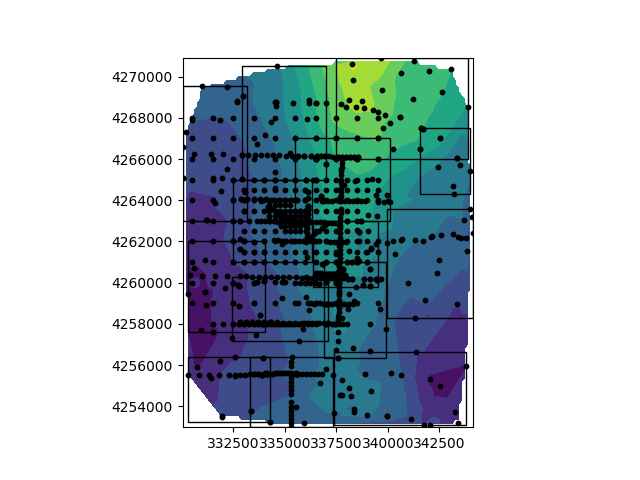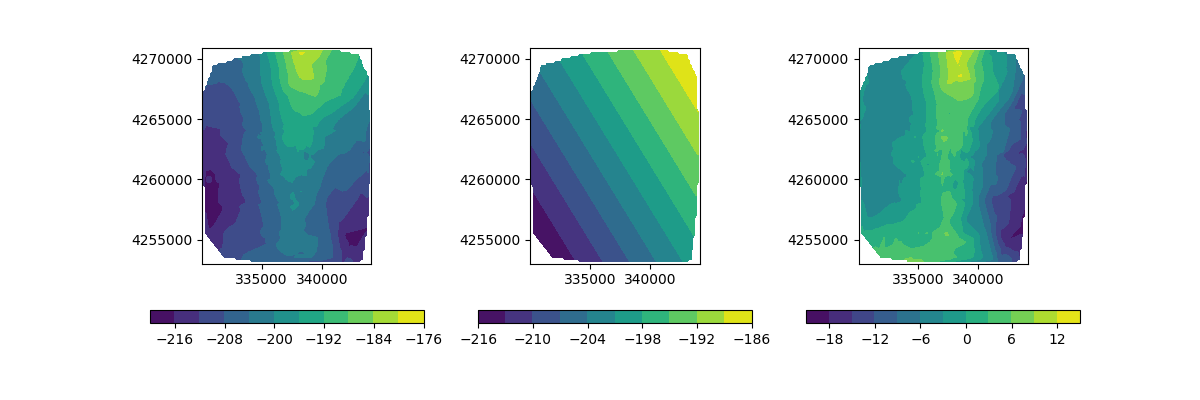Note
Click here to download the full example code
Tile and De-Trend¶
Tile the Inverse Problem and detrend the data
# sphinx_gallery_thumbnail_number = 2
import gdc19
import numpy as np
from discretize import TreeMesh
from discretize.utils import meshutils
import omfvista
import matplotlib.pyplot as plt
from matplotlib.patches import Rectangle
from SimPEG.Utils import mkvc, modelutils, PlotUtils, plot2Ddata
import pyvista
Load the Data¶
Load the mesh and data from the previous example
grav_data = pyvista.read(gdc19.get_gravity_path('grav_obs.vtk'))
xyz = grav_data.points
survey = pyvista.PolyData(xyz)
mesh = TreeMesh.readUBC(gdc19.get_gravity_path('mesh.msh'))
actv = mesh.readModelUBC(gdc19.get_gravity_path('actv.mod'))
Tile the Problem¶
rxLoc = xyz
tiles, binCount, labels = modelutils.tileSurveyPoints(rxLoc, 14)
# Grab the smallest bin and generate a temporary mesh
indMin = np.argmin(binCount)
X1, Y1 = tiles[0][:, 0], tiles[0][:, 1]
X2, Y2 = tiles[1][:, 0], tiles[1][:, 1]
nTiles = X1.shape[0]
fig, ax1 = plt.figure(), plt.subplot()
PlotUtils.plot2Ddata(rxLoc, grav_data.point_arrays['gCBGA'], ax=ax1)
# ax1.scatter(rxLoc[:, 0], rxLoc[:, 1], 10, c='r')
for ii in range(X1.shape[0]):
ind_t = np.all([rxLoc[:, 0] >= X1[ii], rxLoc[:, 0] <= X2[ii],
rxLoc[:, 1] >= Y1[ii], rxLoc[:, 1] <= Y2[ii]],
axis=0
)
ax1.scatter(rxLoc[ind_t, 0], rxLoc[ind_t, 1], 10, c='k')
ax1.add_patch(Rectangle((X1[ii], Y1[ii]),
X2[ii]-X1[ii],
Y2[ii]-Y1[ii],
facecolor='none', edgecolor='k'))
ax1.set_xlim([X1.min()-20, X2.max()+20])
ax1.set_ylim([Y1.min()-20, Y2.max()+20])
ax1.set_aspect('equal')
plt.show()

Out:
/Users/bane/Documents/school/Masters/csm-wteam-github/GeothermalDesignChallenge/project/gravity-inversion/02-tile-detrend.py:68: UserWarning: Matplotlib is currently using agg, which is a non-GUI backend, so cannot show the figure.
plt.show()
Detrend the Data¶
Remove regional trends from the gravity observations.
# Data[X,Y,Z,Mag]
nD = rxLoc.shape[0]
dobs = grav_data.point_arrays['gCBGA']
A = np.c_[np.ones(nD), rxLoc[:,:2]]
# Compute least-squares solution for poly parameters
poly = np.linalg.solve(np.dot(A.T,A), np.dot(A.T,dobs))
# Generate the first-order trend on each points
d = np.dot(A,poly)
dataDetrend = dobs - d
# Plot it out
fig = plt.figure(figsize=(12,4))
ax1 = plt.subplot(1,3,1)
im = plot2Ddata(rxLoc, dobs, ax=ax1)
plt.colorbar(im[0], orientation='horizontal')
ax2 = plt.subplot(1,3,2)
im = plot2Ddata(rxLoc, d, ax=ax2)
plt.colorbar(im[0], orientation='horizontal')
ax3 = plt.subplot(1,3,3)
im = plot2Ddata(rxLoc, dataDetrend, ax=ax3)
plt.colorbar(im[0], orientation='horizontal')

Total running time of the script: ( 0 minutes 14.455 seconds)